The Impact of Solar Radiation at Different Colombian Thermal Floors on an Adsorption Refrigeration Cycle
Abstract
1. Introduction
2. Methodology
2.1. Development of the Theoretical Model of a Solar Thermal System That Operates through an Adsorption Refrigeration Cycle

2.2. Atmospheric Conditions as a Function of El Niño and La Niña Events at Different Altitudes
2.3. Numerical Solution
3. Results and Discussion
4. Conclusions
Author Contributions
Funding
Institutional Review Board Statement
Informed Consent Statement
Data Availability Statement
Acknowledgments
Conflicts of Interest
Appendix A
| Month/City | Phenomenon | Riohacha (3 masl) | Bucaramanga (959 masl) | Cali (1018 masl) | Medellin (1495 masl) | Bogotá (2625 masl) | Tunja (2782 masl) | ||||||
|---|---|---|---|---|---|---|---|---|---|---|---|---|---|
C | kWh/m2/Day | C | kWh/m2/Day | C | kWh/m2/Day | C | kWh/m2/Day | C | kWh/m2/Day | C | kWh/m2/Day | ||
| January | Niño | 26.9 | 5.0 | 21.8 | 3.5 | 24.4 | 4.5 | 22.5 | 4.9 | 13.1 | 5.9 | 13.5 | 5.1 |
| Niña | 27.4 | 5.0 | 23.4 | 5.4 | 24.6 | 5.3 | 24.0 | 4.6 | 17.9 | 5.4 | 17.5 | 5.5 | |
| Typical | 26.9 | 4.5 | 26.6 | 4.8 | 23.7 | 4.4 | 22.4 | 4.3 | 14.5 | 4.1 | 14.0 | 4.7 | |
| February | Niño | 26.8 | 5.4 | 21.9 | 5.0 | 24.2 | 4.0 | 22.8 | 4.8 | 13.7 | 3.5 | 14.1 | 4.4 |
| Niña | 28.5 | 5.0 | 24.0 | 5.3 | 26.8 | 5.1 | 24.7 | 4.5 | 18.4 | 4.4 | 17.7 | 5.1 | |
| Typical | 27.6 | 5.5 | 26.9 | 5.5 | 24.5 | 4.9 | 23.6 | 5.1 | 14.6 | 4.9 | 13.7 | 5.6 | |
| March | Niño | 26.8 | 5.5 | 21.5 | 5.2 | 23.8 | 4.2 | 22.3 | 4.9 | 13.6 | 3.8 | 14.4 | 4.0 |
| Niña | 29.0 | 5.6 | 24.0 | 5.4 | 22.2 | 4.8 | 24.9 | 4.4 | 18.8 | 4.1 | 18.5 | 5.3 | |
| Typical | 27.7 | 5.1 | 26.6 | 4.3 | 24.1 | 4.3 | 22.1 | 3.7 | 14.7 | 3.0 | 15.4 | 4.4 | |
| April | Niño | 28.0 | 5.6 | 21.8 | 5.2 | 24.0 | 4.0 | 21.9 | 4.4 | 14.5 | 3.4 | 15.6 | 3.8 |
| Niña | 29.1 | 5.3 | 23.0 | 4.3 | 22.0 | 4.5 | 23.8 | 3.9 | 17.3 | 3.3 | 17.3 | 4.0 | |
| Typical | 29.8 | 5.5 | 26.5 | 5.0 | 24.7 | 4.8 | 22.9 | 4.0 | 15.5 | 3.8 | 14.4 | 4.8 | |
| May | Niño | 28.5 | 5.2 | 22.1 | 4.8 | 24.6 | 4.2 | 22.7 | 4.4 | 18.2 | 3.7 | 15.6 | 3.5 |
| Niña | 30.6 | 5.4 | 22.9 | 5.6 | 25.3 | 4.4 | 23.8 | 5.2 | 16.6 | 3.9 | 17.7 | 4.6 | |
| Typical | 30.0 | 5.8 | 26.4 | 4.1 | 24.2 | 4.2 | 22.8 | 4.2 | 15.8 | 3.6 | 14.7 | 4.3 | |
| June | Niño | 29.4 | 5.5 | 22.3 | 3.0 | 24.2 | 4.1 | 22.7 | 4.9 | 14.0 | 4.0 | 14.9 | 3.9 |
| Niña | 32.0 | 6.4 | 23.2 | 5.2 | 25.5 | 4.4 | 23.9 | 5.3 | 18.8 | 4.0 | 16.3 | 4.1 | |
| Typical | 30.1 | 6.1 | 24.3 | 4.2 | 24.2 | 4.4 | 23.0 | 4.4 | 18.4 | 3.6 | 14.6 | 3.9 | |
| July | Niño | 29.1 | 5.6 | 21.6 | 3.2 | 23.8 | 4.1 | 22.2 | 4.6 | 13.7 | 3.9 | 14.9 | 4.0 |
| Niña | 31.4 | 6.0 | 23.2 | 5.6 | 25.6 | 4.3 | 24.0 | 5.0 | 19.1 | 4.2 | 15.8 | 4.3 | |
| Typical | 30.3 | 6.1 | 25.6 | 4.2 | 24.9 | 5.0 | 23.7 | 4.8 | 18.2 | 4.1 | 14.1 | 3.4 | |
| August | Niño | 28.4 | 5.4 | 22.1 | 3.1 | 24.5 | 4.4 | 22.9 | 5.0 | 13.2 | 3.6 | 13.8 | 4.5 |
| Niña | 29.5 | 6.4 | 23.4 | 5.5 | 26.2 | 4.6 | 23.9 | 4.9 | 16.6 | 4.2 | 15.9 | 4.1 | |
| Typical | 29.7 | 6.1 | 27.4 | 4.4 | 24.5 | 5.2 | 23.5 | 4.8 | 18.7 | 4.2 | 13.8 | 4.4 | |
| September | Niño | 27.6 | 5.1 | 21.6 | 3.1 | 24.0 | 4.1 | 21.8 | 4.6 | 13.7 | 3.9 | 14.4 | 4.1 |
| Niña | 30.0 | 6.0 | 23.5 | 5.5 | 26.7 | 4.6 | 24.3 | 5.0 | 16.5 | 4.1 | 15.5 | 4.4 | |
| Typical | 29.4 | 5.5 | 27.0 | 4.7 | 17.9 | 5.3 | 23.0 | 4.2 | 19.1 | 4.2 | 13.5 | 4.6 | |
| October | Niño | 28.1 | 5.0 | 21.7 | 3.8 | 23.9 | 4.2 | 22.4 | 4.7 | 14.0 | 4.0 | 14.8 | 4.3 |
| Niña | 29.1 | 4.8 | 23.4 | 5.1 | 25.6 | 4.3 | 23.3 | 4.0 | 16.8 | 4.1 | 16.0 | 4.4 | |
| Typical | 28.9 | 5.0 | 26.3 | 4.7 | 24.0 | 4.2 | 22.4 | 3.9 | 17.3 | 3.8 | 14.0 | 4.5 | |
| November | Niño | 26.8 | 3.8 | 21.2 | 3.6 | 23.2 | 3.4 | 21.6 | 4.2 | 14.1 | 3.4 | 15.1 | 3.6 |
| Niña | 28.5 | 4.3 | 22.5 | 4.6 | 24.8 | 4.7 | 23.0 | 3.9 | 16.5 | 3.8 | 15.8 | 4.1 | |
| Typical | 28.2 | 4.4 | 27.0 | 4.6 | 17.4 | 4.4 | 22.4 | 3.9 | 17.3 | 3.5 | 14.5 | 4.6 | |
| December | Niño | 26.7 | 4.1 | 21.0 | 3.0 | 23.4 | 3.6 | 21.9 | 4.2 | 13.4 | 4.1 | 14.4 | 4.2 |
| Niña | 28.8 | 4.4 | 23.9 | 5.1 | 25.8 | 5.8 | 24.0 | 4.2 | 16.7 | 4.1 | 15.4 | 4.7 | |
| Typical | 28.0 | 4.7 | 26.8 | 5.1 | 17.6 | 4.3 | 22.4 | 4.3 | 16.9 | 3.9 | 13.6 | 5.1 | |
References
- Ho, C.; Lee, H.W.; Gambatese, J.A. Application of Prevention through Design (PtD) to improve the safety of solar installations on small buildings. Saf. Sci. 2020, 125, 104633. [Google Scholar] [CrossRef]
- Rathore, P.K.S.; Chauhan, D.S.; Singh, R.P. Decentralized solar rooftop photovoltaic in India: On the path of sustainable energy security. Renew. Energy 2019, 131, 297–307. [Google Scholar] [CrossRef]
- Yang, J.; Yang, Z.; Duan, Y. Off-design performance of a supercritical CO2 Brayton cycle integrated with a solar power tower system. Energy 2020, 201, 117676. [Google Scholar] [CrossRef]
- Mohammadi, K.; Goudarzi, N. Study of inter-correlations of solar radiation, wind speed and precipitation under the influence of El Niño Southern Oscillation (ENSO) in California. Renew. Energy 2018, 120, 190–200. [Google Scholar] [CrossRef]
- Suhadah, N.; Fadzil, M.; Heng, P.; Rabitah, N.; Khalil, I.; Hidayah, N. Spatial and temporal variability of sea surface temperature during El-Niño Southern Oscillation and Indian Ocean Dipole in the Strait of Malacca and Andaman Sea. Reg. Stud. Mar. Sci. 2020, 39, 101402. [Google Scholar] [CrossRef]
- Laguarda, A.; Alonso-Suárez, R.; Terra, R. Solar irradiation regionalization in Uruguay: Understanding the interannual variability and its relation to El Niño climatic phenomena. Renew. Energy 2020, 158, 444–452. [Google Scholar] [CrossRef]
- Montealegre Bocanegra, J.E.; Pabon Caicedo, J.D. La variabilidad climatica interanual asociada al ciclo el Niño-La Niña–Oscilacion del sur y su efecto en el patron pluviometrico de Colombia. Meteorol. Colomb. 2000, 2, 7–21. [Google Scholar]
- Leggett, L.M.W.; Ball, D.A. The implication for climate change and peak fossil fuel of the continuation of the current trend in wind and solar energy production. Energy Policy 2012, 41, 610–617. [Google Scholar] [CrossRef]
- Oka, K.; Mizutani, W.; Ashina, S. Climate change impacts on potential solar energy production: A study case in Fukushima, Japan. Renew. Energy 2020, 153, 249–260. [Google Scholar] [CrossRef]
- Ospino Castro, A.J. Análisis del potencial energético solar en la Región Caribe para el diseño de un sistema fotovoltaico. Inge-Cuc 2010, 6, 85–94. [Google Scholar]
- Vanegas Chamorro, M.; Villicaña Ortíz, E.; Arrieta Viana, L. Cuantificación y caracterización de la radiación solar en el departamento de La Guajira-Colombia mediante el calculo de transmisibilidad atmosférica. Prospectiva 2015, 13, 54–63. [Google Scholar] [CrossRef][Green Version]
- National Aeronautics and Space Administration-NASA. POWER Data Access Viewer. Available online: https://power.larc.nasa.gov/data-access-viewer/ (accessed on 24 November 2022).
- Instituto de Hidrología Meteorología y Estudios Ambientales—IDEAM. Datos Hidrológicos y Meteorológicos—DHIME. Available online: http://dhime.ideam.gov.co/webgis/home/ (accessed on 24 November 2022).
- Fernandes, M.; Brites, G.; Costa, J.; Gaspar, A.; Costa, V. Review and future trends of solar adsorption refrigeration systems. Renew. Sustain. Energy Rev. 2014, 39, 102–123. [Google Scholar] [CrossRef]
- Wang, L.W.; Wang, R.Z.; Oliveira, R.G. A review on adsorption working pairs for refrigeration. Renew. Sustain. Energy Rev. 2009, 13, 518–534. [Google Scholar] [CrossRef]
- Sarbu, I.; Sebarchievici, C. Review of solar refrigeration and cooling systems. Energy Build. 2013, 67, 286–297. [Google Scholar] [CrossRef]
- Wang, D.C.; Li, Y.H.; Li, D.; Xia, Y.Z.; Zhang, J.P. A review on adsorption refrigeration technology and adsorption deterioration in physical adsorption systems. Renew. Sustain. Energy Rev. 2010, 14, 344–353. [Google Scholar] [CrossRef]
- El-Sharkawy, I.I.; Hassan, M.; Saha, B.B.; Koyama, S.; Nasr, M.M. Study on adsorption of methanol onto carbon based adsorbents. Int. J. Refrig. 2009, 32, 1579–1586. [Google Scholar] [CrossRef]
- Ghafoor, A.; Munir, A. Worldwide overview of solar thermal cooling technologies. Renew. Sustain. Energy Rev. 2015, 43, 763–774. [Google Scholar] [CrossRef]
- Fong, K.F.; Chow, T.T.; Lee, C.K.; Lin, Z.; Chan, L.S. Comparative study of different solar cooling systems for buildings in subtropical city. Sol. Energy 2010, 84, 227–244. [Google Scholar] [CrossRef]
- Zhao, C.; Wang, Y.; Li, M.; Zhao, W.; Li, X.; Yu, Q.; Huang, M. Impact of three different enhancing mass transfer operating characteristics on a solar adsorption refrigeration system with compound parabolic concentrator. Renew. Energy 2020, 152, 1354–1366. [Google Scholar] [CrossRef]
- Zhao, C.; Wang, Y.; Li, M.; Zhao, W.; Li, X.; Du, W.; Yu, Q. Experimental study of a solar adsorption refrigeration system integrated with a compound parabolic concentrator based on an enhanced mass transfer cycle in Kunming, China. Sol. Energy 2020, 195, 37–46. [Google Scholar] [CrossRef]
- Wang, R.Z.; Oliveira, R.G. Adsorption refrigeration-An efficient way to make good use of waste heat and solar energy. Prog. Energy Combust. Sci. 2006, 32, 424–458. [Google Scholar] [CrossRef]
- Allouhi, A.; Kousksou, T.; Jamil, A.; Bruel, P.; Mourad, Y.; Zeraouli, Y. Solar driven cooling systems: An updated review. Renew. Sustain. Energy Rev. 2015, 44, 159–181. [Google Scholar] [CrossRef]
- Camargo, A.J.; Quintero, J.G.; Avila, L.A.; Gutierrez, G.A. Potencial Termodinámico de un Refrigerador Intermitente por Adsorción bajo las Condiciones Climáticas de Riohacha, en Colombia. Inf. Tecnol. 2019, 30, 139–146. [Google Scholar] [CrossRef]
- Li, Z.F.; Sumathy, K. A solar-powered ice-maker with the solid adsorption pair of activated carbon and methanol. Int. J. Energy Res. 1999, 23, 517–527. [Google Scholar] [CrossRef]
- Hassan, H.; Mohamad, A.; Alyousef, Y.; Al-ansary, H. A review on the equations of state for the working pairs used in adsorption cooling systems. Renew. Sustain. Energy Rev. 2015, 45, 600–609. [Google Scholar] [CrossRef]
- National Weather Service—NOAA. Climate Prediction Center. Available online: https://origin.cpc.ncep.noaa.gov/products/analysis_monitoring/ensostuff/ONI_v5.php (accessed on 2 February 2023).

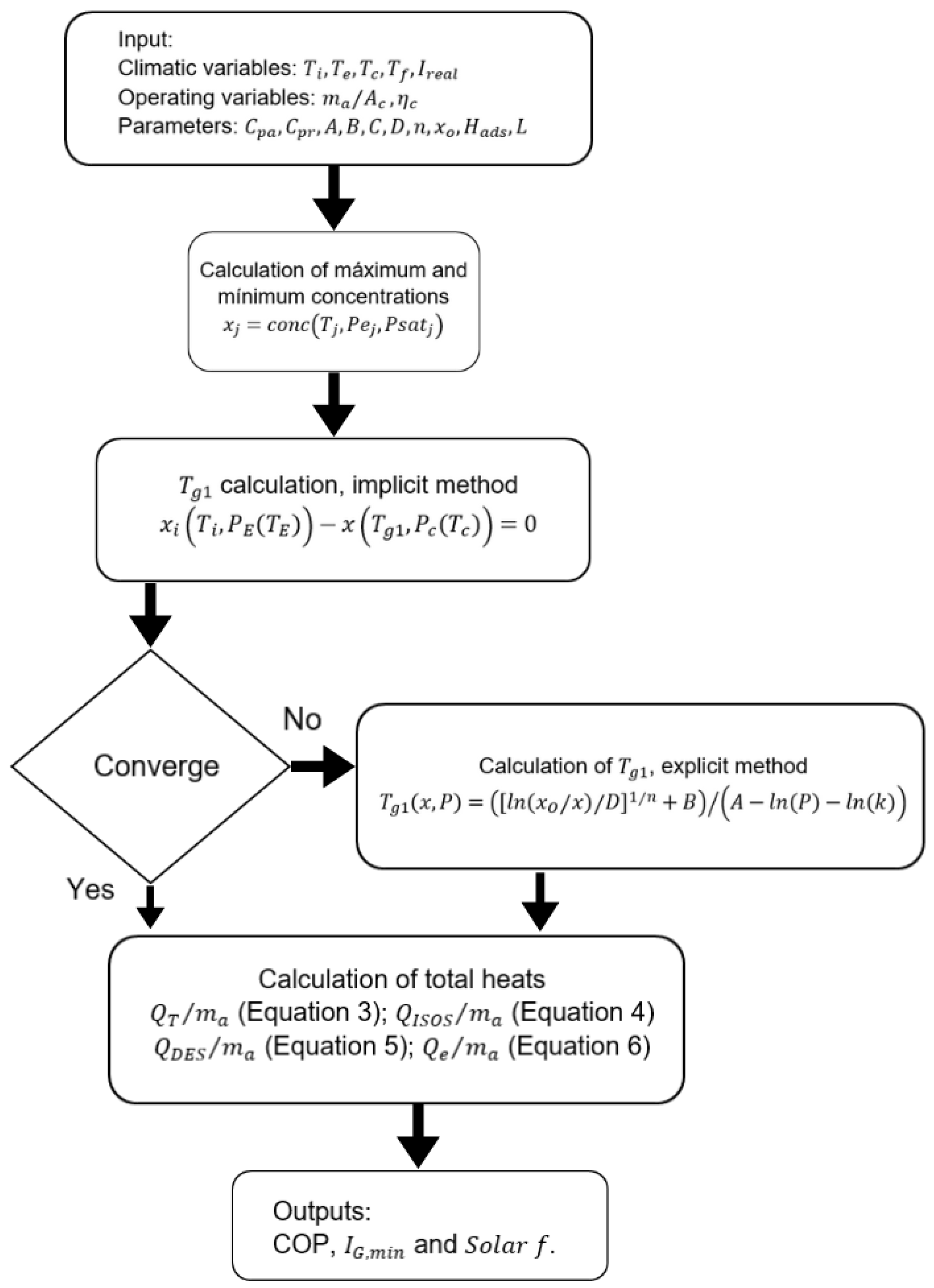
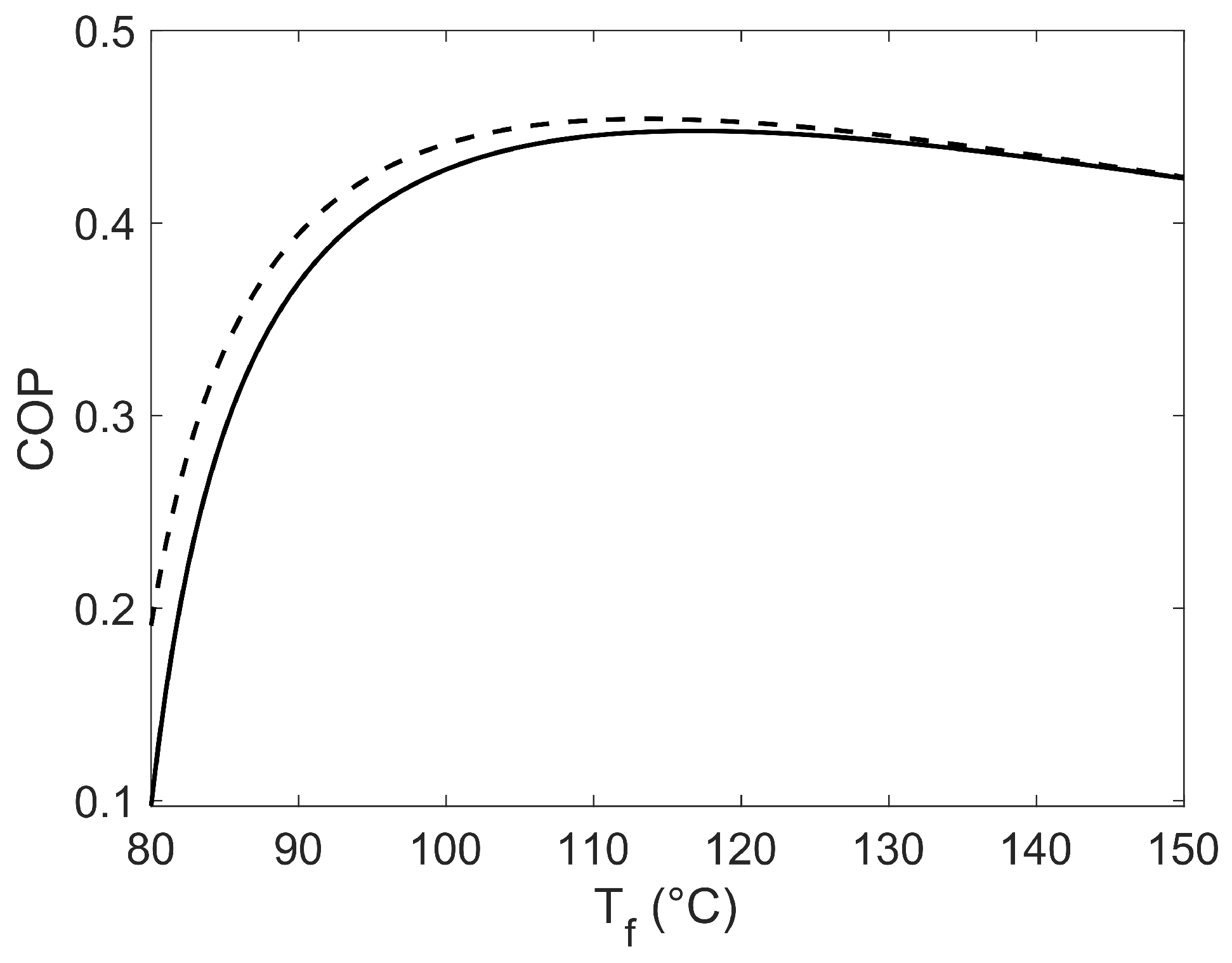
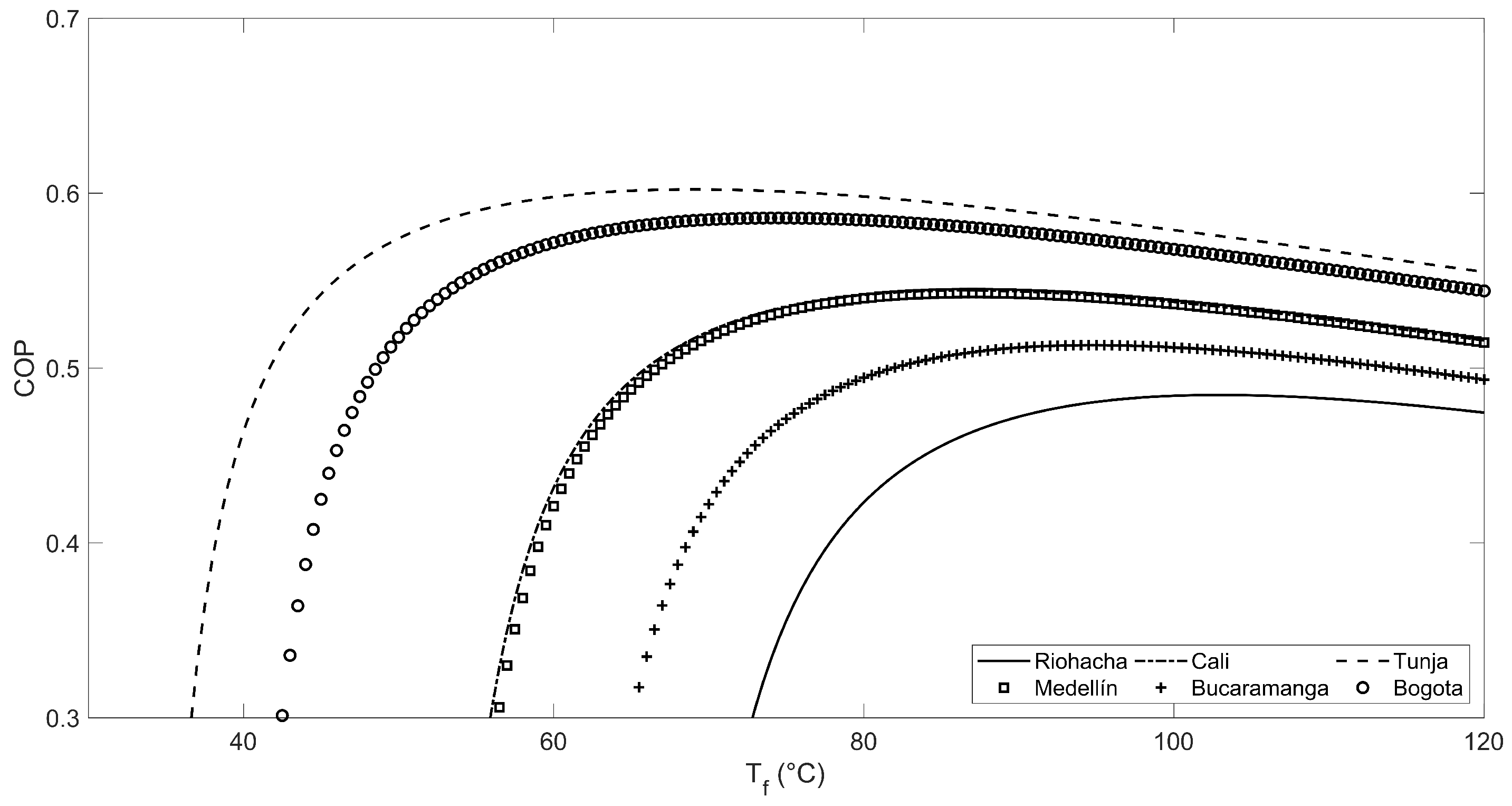
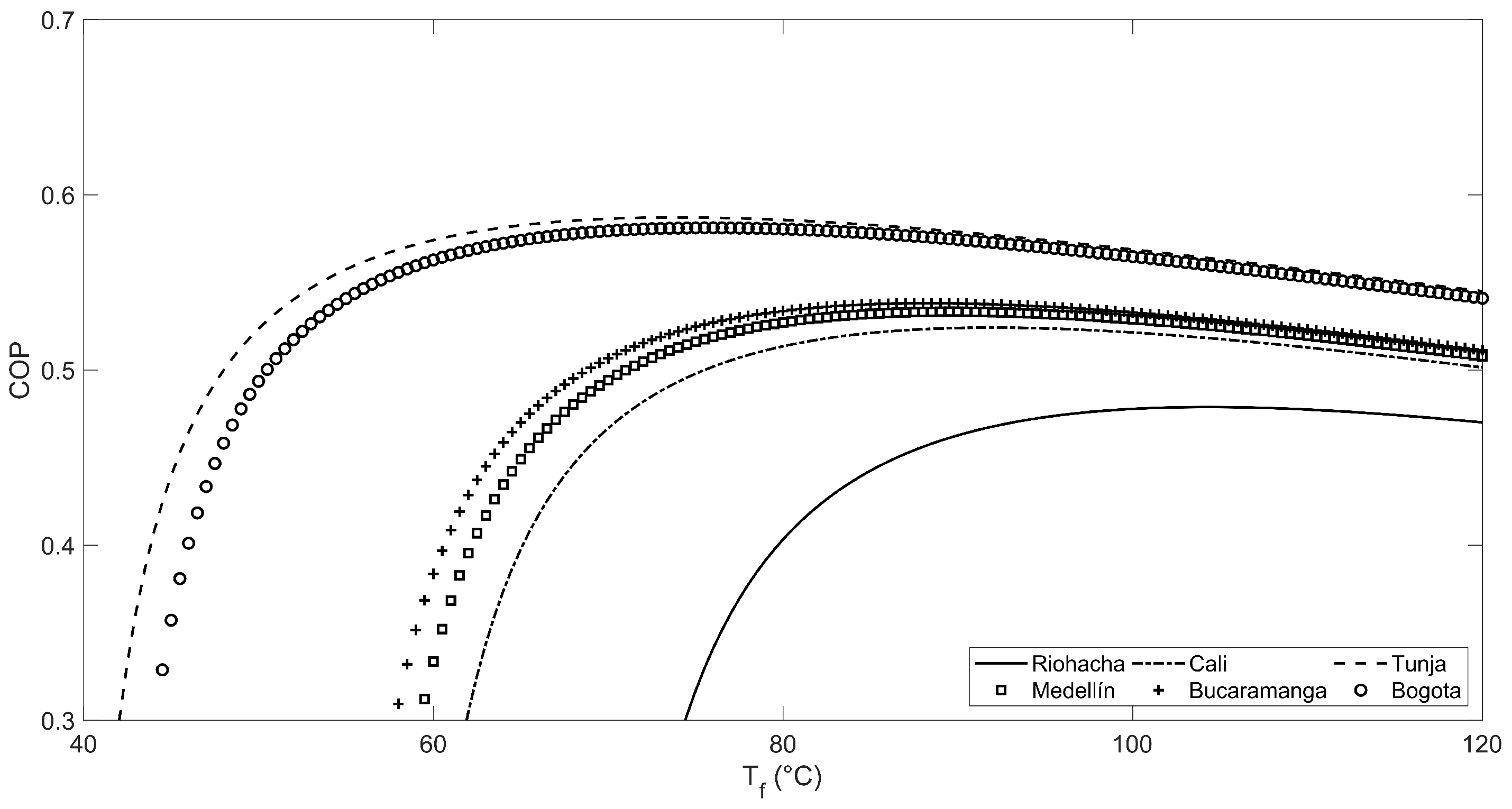
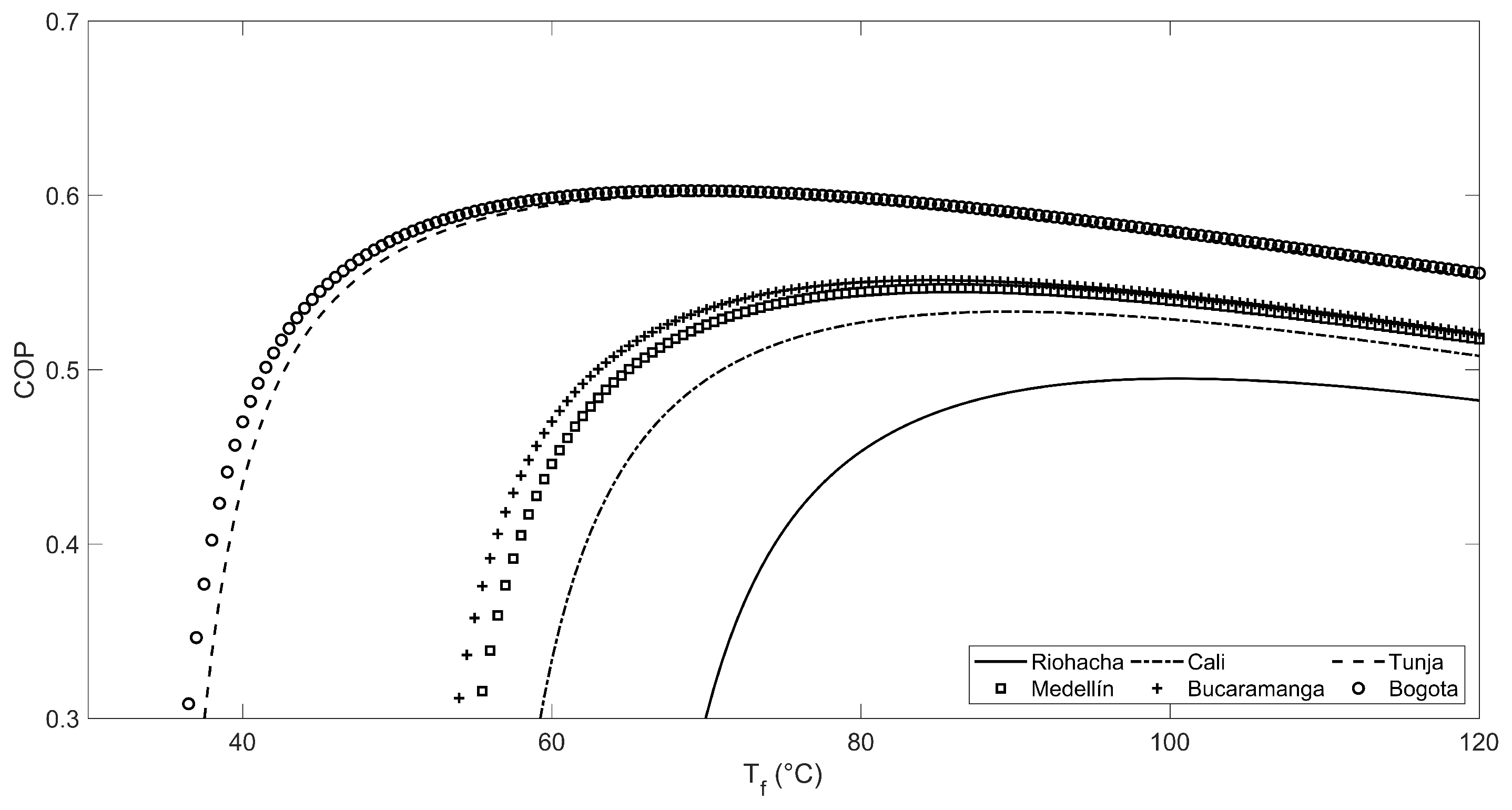
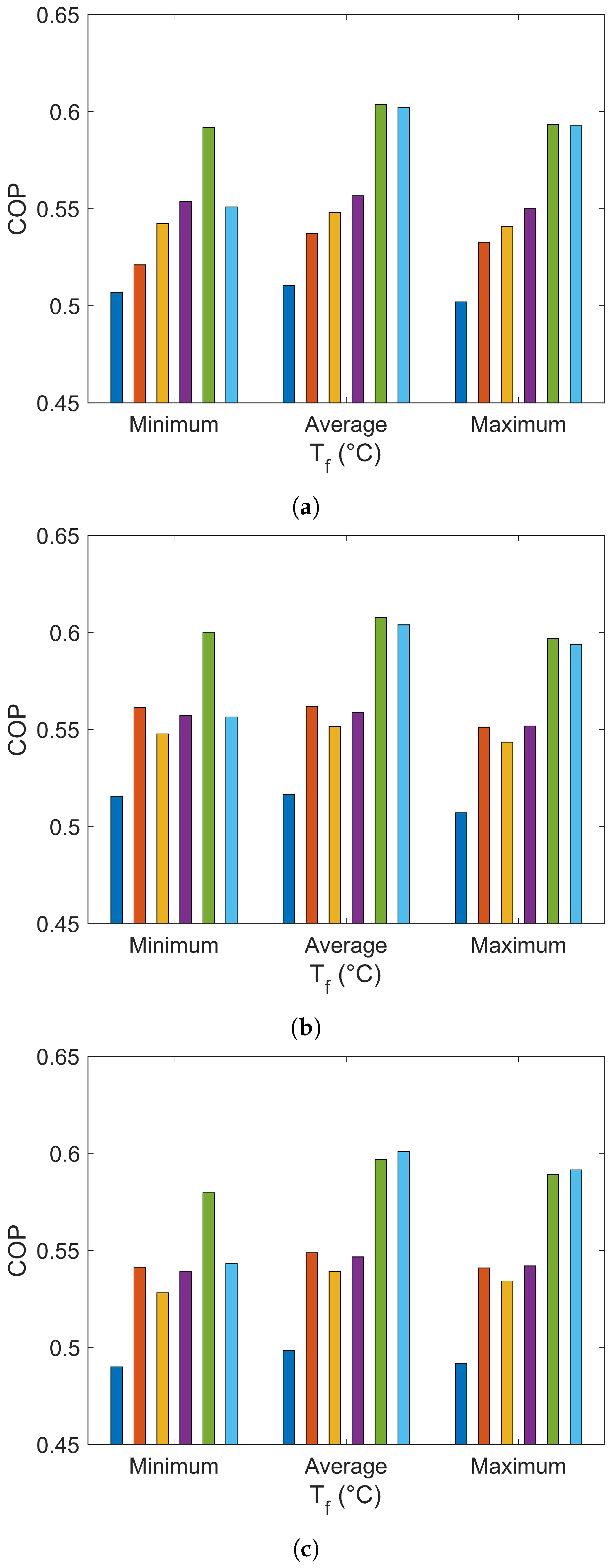
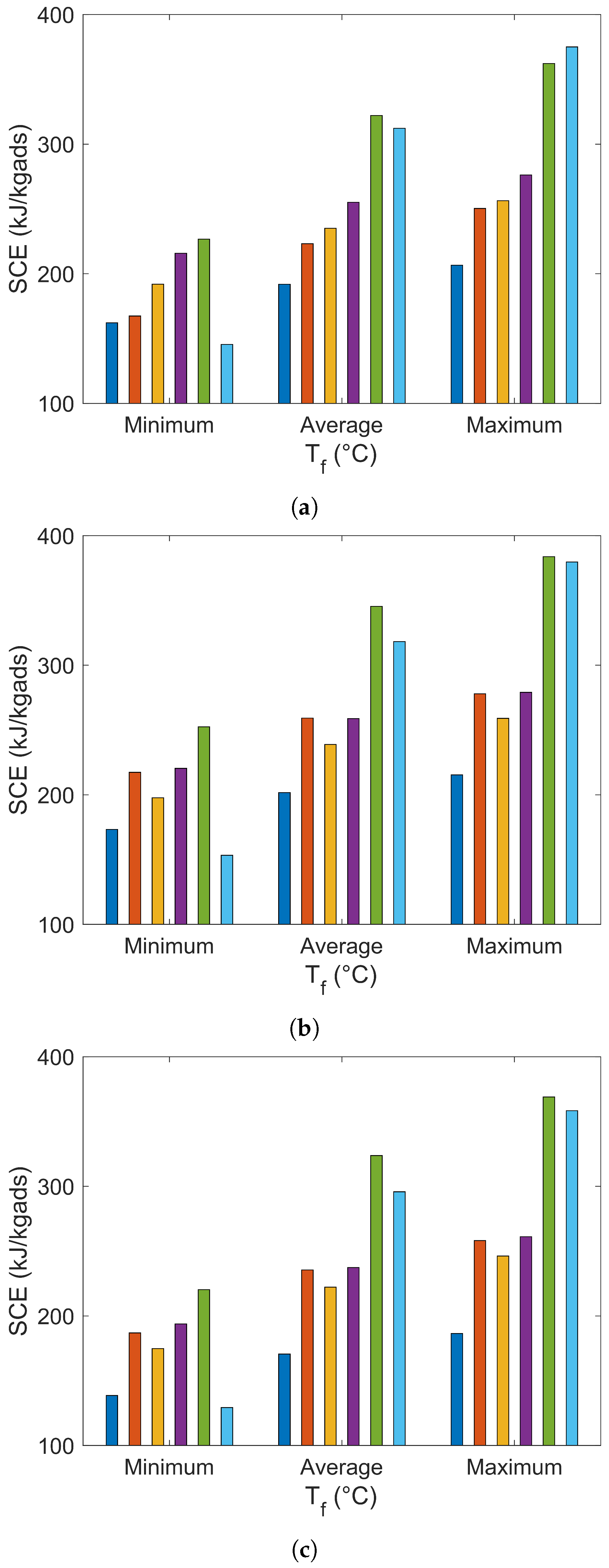
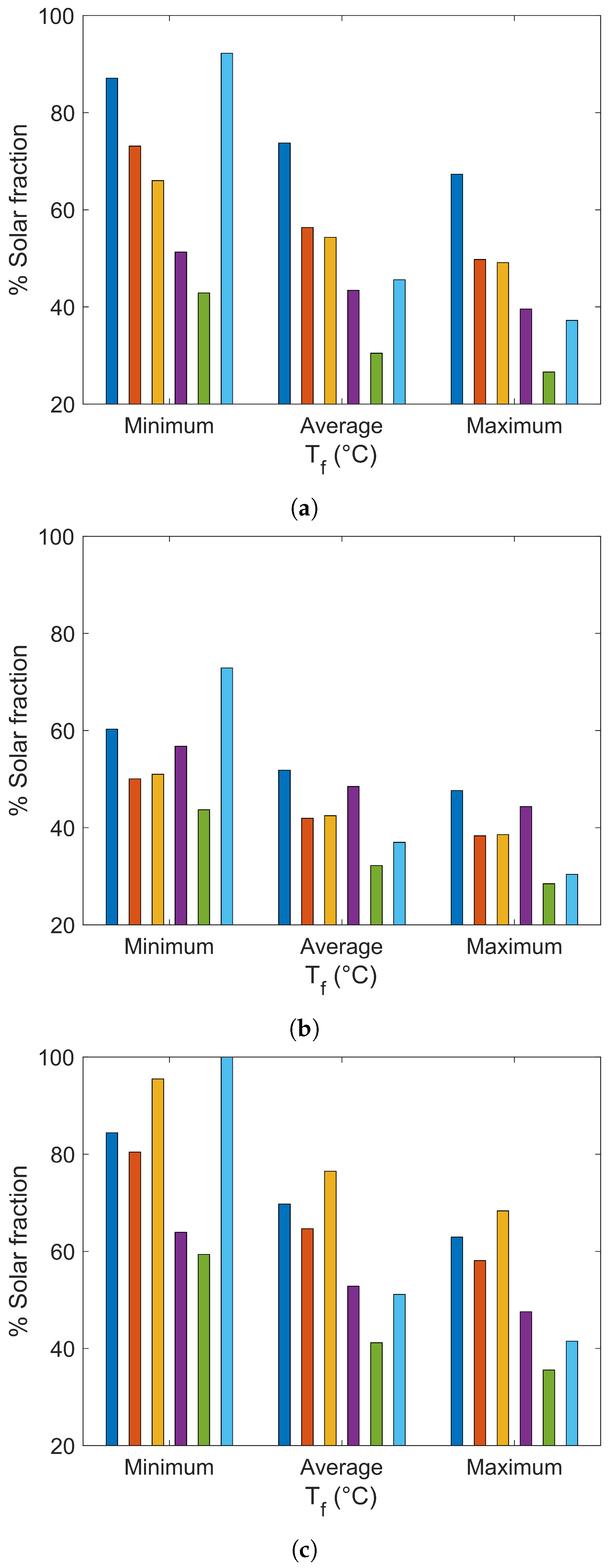
| Año | DJF | JFM | FMA | MAM | AMJ | MJJ | JJA | JAS | ASO | SON | OND | NDJ |
|---|---|---|---|---|---|---|---|---|---|---|---|---|
| 2010 | −0.6 | −1.0 | −1.4 | −1.6 | −1.7 | −1.7 | −1.6 | |||||
| 2011 | −1.4 | −1.1 | −0.8 | −0.6 | −0.5 | |||||||
| 2015 | 1.0 | 1.2 | 1.5 | 1.8 | 2.1 | 2.4 | 2.5 | 2.6 | ||||
| 2016 | 2.5 | 2.2 | 1.7 | 1.0 | ||||||||
| 2017 | −0.3 | −0.1 | 0.1 | 0.3 | 0.4 | 0.4 | 0.2 | −0.1 | −0.4 | −0.7 | −0.9 | −1.0 |
| City | Final Temperatures (C) | La Niña Phenomenon | El Niño Phenomenon | Typical Year | |||||||||
|---|---|---|---|---|---|---|---|---|---|---|---|---|---|
| COP | SCE (kJ/kgads) | Solar f. | Ice Days | COP | SCE (kJ/kgads) | Solar f. | Ice Days | COP | SCE (kJ/kgads) | Solar f. | Ice Days | ||
| Riohacha (3 masl) | = 89.34 | 0.51 | 167.09 | 0.86 | 91 | 0.49 | 140.34 | 1.03 | 174 | 0.49 | 147.52 | 1.00 | 165 |
| = 102.11 | 0.51 | 197.13 | 0.73 | 19 | 0.50 | 173.53 | 0.84 | 97 | 0.50 | 179.59 | 0.82 | 85 | |
| = 114.88 | 0.50 | 211.87 | 0.67 | 0 | 0.46 | 201.50 | 0.67 | 0 | 0.46 | 206.28 | 0.65 | 0 | |
| Bucaramanga (959 masl) | = 75.32 | 0.56 | 211.96 | 0.55 | 0 | 0.54 | 182.44 | 0.83 | 65 | 0.52 | 173.11 | 0.77 | 35 |
| = 89.06 | 0.56 | 254.92 | 0.46 | 0 | 0.55 | 231.85 | 0.67 | 0 | 0.54 | 228.33 | 0.59 | 0 | |
| = 102.79 | 0.55 | 274.25 | 0.42 | 0 | 0.54 | 256.11 | 0.59 | 0 | 0.53 | 255.22 | 0.53 | 0 | |
| Cali (1018 masl) | = 76.73 | 0.53 | 180.88 | 0.65 | 3 | 0.53 | 172.77 | 0.79 | 55 | 0.55 | 215.94 | 0.66 | 10 |
| = 89.44 | 0.54 | 226.09 | 0.53 | 1 | 0.54 | 220.57 | 0.63 | 2 | 0.56 | 256.09 | 0.55 | 0 | |
| = 102.16 | 0.54 | 249.64 | 0.47 | 0 | 0.53 | 245.91 | 0.56 | 0 | 0.55 | 275.60 | 0.50 | 0 | |
| Medellín (1495 masl) | = 76.52 | 0.55 | 211.70 | 0.66 | 4 | 0.54 | 191.70 | 0.70 | 9 | 0.55 | 207.42 | 0.62 | 0 |
| = 88.44 | 0.56 | 251.57 | 0.55 | 0 | 0.55 | 235.19 | 0.58 | 1 | 0.55 | 248.47 | 0.52 | 0 | |
| = 100.37 | 0.55 | 272.87 | 0.50 | 0 | 0.54 | 258.96 | 0.52 | 0 | 0.55 | 270.57 | 0.47 | 0 | |
| Bogotá (2625 masl) | = 54.26 | 0.60 | 253.79 | 0.51 | 3 | 0.57 | 191.62 | 0.68 | 25 | 0.57 | 184.54 | 0.67 | 26 |
| = 71.39 | 0.61 | 346.64 | 0.37 | 0 | 0.59 | 298.44 | 0.45 | 0 | 0.59 | 288.38 | 0.43 | 0 | |
| = 88.51 | 0.60 | 385.05 | 0.33 | 0 | 0.58 | 346.05 | 0.38 | 0 | 0.59 | 333.99 | 0.37 | 0 | |
| Tunja (2782 masl) | = 44.43 | 0.56 | 170.11 | 0.76 | 55 | 0.52 | 117.63 | 1.14 | 214 | 0.57 | 187.85 | 0.78 | 59 |
| = 66.54 | 0.61 | 332.75 | 0.41 | 0 | 0.60 | 290.24 | 0.50 | 0 | 0.61 | 348.23 | 0.43 | 0 | |
| = 88.66 | 0.60 | 392.68 | 0.34 | 0 | 0.59 | 357.69 | 0.40 | 0 | 0.60 | 406.64 | 0.36 | 0 | |
Disclaimer/Publisher’s Note: The statements, opinions and data contained in all publications are solely those of the individual author(s) and contributor(s) and not of MDPI and/or the editor(s). MDPI and/or the editor(s) disclaim responsibility for any injury to people or property resulting from any ideas, methods, instructions or products referred to in the content. |
© 2023 by the authors. Licensee MDPI, Basel, Switzerland. This article is an open access article distributed under the terms and conditions of the Creative Commons Attribution (CC BY) license (https://creativecommons.org/licenses/by/4.0/).
Share and Cite
Serrano-Florez, D.; Camargo, A.J.; Gutierrez, G.; Bastidas-Barranco, M.; Chica, E.; Colorado, A. The Impact of Solar Radiation at Different Colombian Thermal Floors on an Adsorption Refrigeration Cycle. Processes 2023, 11, 2499. https://doi.org/10.3390/pr11082499
Serrano-Florez D, Camargo AJ, Gutierrez G, Bastidas-Barranco M, Chica E, Colorado A. The Impact of Solar Radiation at Different Colombian Thermal Floors on an Adsorption Refrigeration Cycle. Processes. 2023; 11(8):2499. https://doi.org/10.3390/pr11082499
Chicago/Turabian StyleSerrano-Florez, Dario, Aduar J. Camargo, Gail Gutierrez, Marlon Bastidas-Barranco, Edwin Chica, and Andres Colorado. 2023. "The Impact of Solar Radiation at Different Colombian Thermal Floors on an Adsorption Refrigeration Cycle" Processes 11, no. 8: 2499. https://doi.org/10.3390/pr11082499
APA StyleSerrano-Florez, D., Camargo, A. J., Gutierrez, G., Bastidas-Barranco, M., Chica, E., & Colorado, A. (2023). The Impact of Solar Radiation at Different Colombian Thermal Floors on an Adsorption Refrigeration Cycle. Processes, 11(8), 2499. https://doi.org/10.3390/pr11082499








